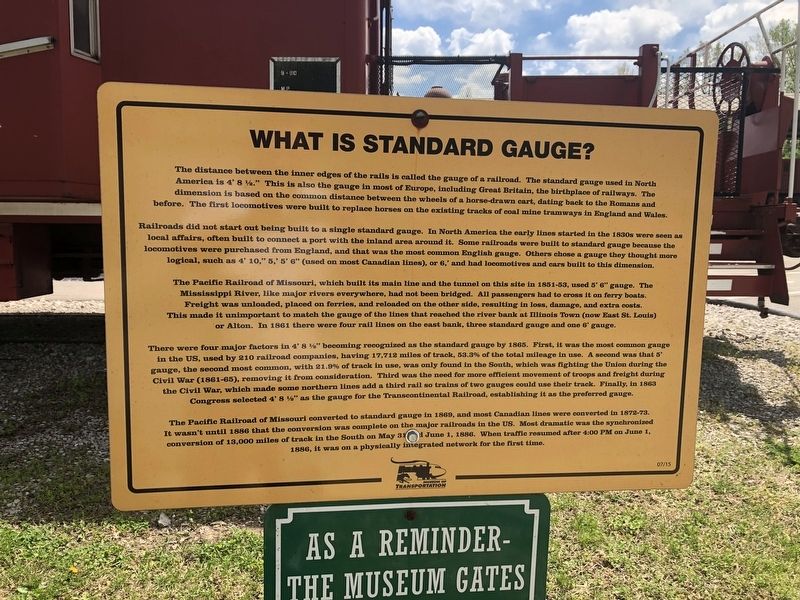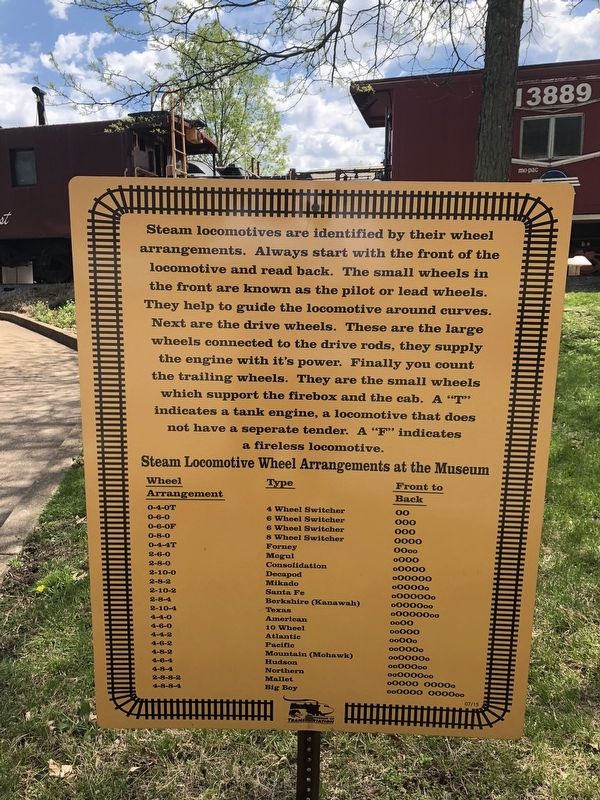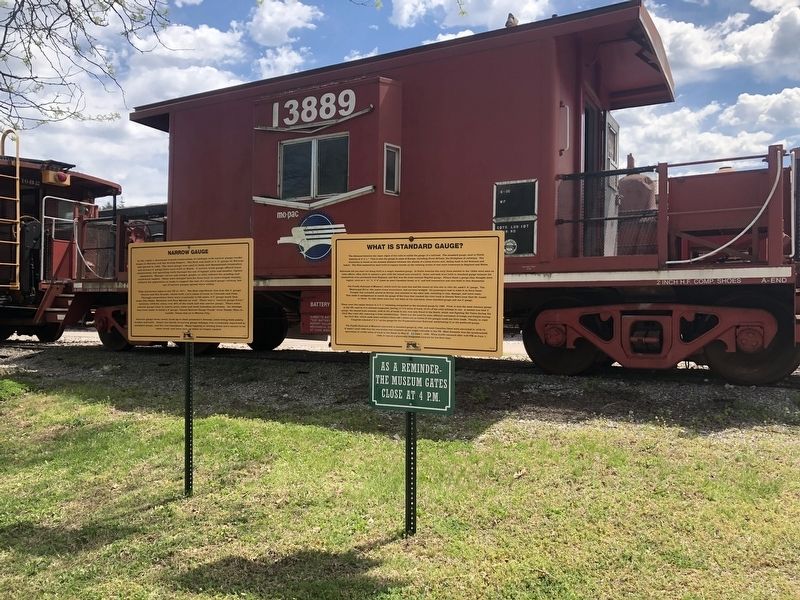National Museum of Transportation near Kirkwood in St. Louis County, Missouri — The American Midwest (Upper Plains)
What Is Standard Gauge?
Museum of Transportation
The distance between the inner edges of the rails is called the gauge of a railroad. The standard gauge used in North America is 4' 8½." This is also the gauge in most of Europe, including Great Britain, the birthplace of railways. The dimension is based on the common distance between the wheels of a horse-drawn cart, dating back to the Romans and before. The first locomotives were built to replace horses on the existing tracks of coal mine tramways in England and Wales.
Railroads did not start out being built to a single standard gauge. In North America the early lines started in the 1830s were seen as local affairs, often built to connect a port with the inland area around it. Some railroads were built to standard gauge because the locomotives were purchased from England, and that was the most common English gauge. Others chose a gauge they thought more logical, such as 4' 10," 5,' 5' 6" (used on most Canadian lines), or 6,' and had locomotives and cars built to this dimension.
The Pacific Railroad of Missouri, which built its main line and the tunnel on this site in 1851-53, used 5' 6" gauge. The Mississippi River, like major rivers everywhere, had not been bridged. All passengers had to cross it on ferry boats. Freight was unloaded, placed on ferries, and reloaded on the other side, resulting in loss, damage, and extra costs. This made it unimportant to match the gauge of the lines that reached the river bank at Illinois Town (now East St. Louis) or Alton. In 1861 there were four rail lines on the east bank, three standard gauge and one 6' gauge.
There were four major factors in 4' 8 ½" becoming recognized as the standard gauge by 1865. First it was the most common gauge in the US, used by 210 railroad companies, having 17,712 miles of track, 53.3% of the total mileage in use. A second was that 5' gauge, the second most common, with 21.9% of track use, was only found in the South, which was fighting the Union during the Civil War (1861-65) removing it from consideration. Third was the need for more efficient movement of troops and freight during the Civil War, which made some northern lines add a third rail so trains of two gauges could use their track. Finally, in 1863 Congress selected 4' 8 ½" as the gauge for the Transcontinental Railroad, establishing it as the preferred gauge.
The Pacific Railroad of Missouri converted to standard gauge in 1869, and most Canadian lines were converted in 1872-73. It wasn't until 1886 that the conversion was complete on the major railroads in the US. Most dramatic was the synchronized conversion of 13,000 miles of track in the South on May 31 and June 1, 1886. When traffic resumed after 4:00 PM on June 1, 1886,
Erected 2015 by Museum of Transportation.
Topics. This historical marker is listed in these topic lists: Railroads & Streetcars • War, US Civil. A significant historical date for this entry is May 31, 1861.
Location. 38° 34.269′ N, 90° 27.809′ W. Marker is near Kirkwood, Missouri, in St. Louis County. It is in National Museum of Transportation. Marker can be reached from Barrett Station Road east of Old Dougherty Ferry Road, on the right when traveling east. Touch for map. Marker is at or near this postal address: 3015 Barrett Station Road, Saint Louis MO 63122, United States of America. Touch for directions.
Other nearby markers. At least 8 other markers are within walking distance of this marker. Narrow Gauge (here, next to this marker); #13889 (a few steps from this marker); #724 (a few steps from this marker); #1082 (a few steps from this marker); #1 (a few steps from this marker); #1149 (a few steps from this marker); #6117 (a few steps from this marker); #884 (within shouting distance of this marker). Touch for a list and map of all markers in Kirkwood.
Credits. This page was last revised on April 24, 2020. It was originally submitted on April 28, 2019, by Devry Becker Jones of Washington, District of Columbia. This page has been viewed 164 times since then and 23 times this year. Photos: 1, 2, 3. submitted on April 28, 2019, by Devry Becker Jones of Washington, District of Columbia.


